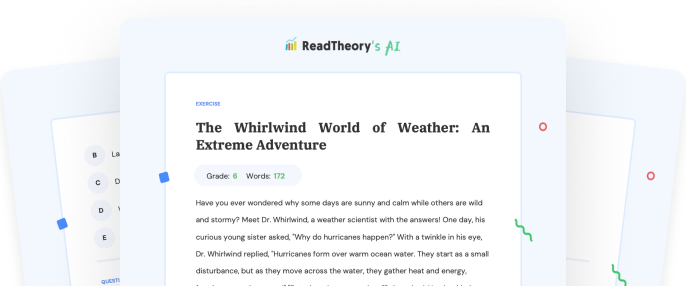Transform Your Teaching
with AI-Powered Worksheets
With ReadTheory’s Instant Worksheet Builder, you can create engaging, grade-appropriate worksheets tailored to your students in minutes. Spark curiosity, save time, and empower critical thinking with AI-powered tools designed for teachers like you.


Bravery and Resistance: Lessons from the Holocaust
Between 1941 and 1945, one of the darkest periods in human history unfolded, known as the Holocaust. It was a time of great sorrow and loss, yet amidst the darkness, there were sparks of bravery and resistance. Ordinary people showcased extraordinary courage, standing up against the oppressive Nazi regime. Take Anne Frank, for example, a young girl who became a symbol of resilience and hope. She and her family hid from the Nazis for two years in a secret annex in Amsterdam, during which time she kept a diary that would later shed light on the horrors they faced. Then there was Miep Gies, one of the Dutch citizens who risked her life to help hide the Franks and other Jews. These are just two examples of the countless acts of bravery exhibited during the Holocaust. The Holocaust serves as an unfortunate reminder of the destructive power of discrimination and prejudice. It also underscores the importance of tolerance, understanding, and standing up for what's right in the face of adversity.
Question 1
Who risked their life to help hide the Franks and other Jews?
Anne Frank
Adolf Hitler
Miep Gies
Benito Mussolini
Franklin Roosevelt
Question 2
What did Anne Frank become a symbol of during the Holocaust?
Fear
Hate
Resilience and Hope
Pain
Sorrow
Question 3
What is the meaning of 'annex' as used in the text?
A meeting
A form of punishment
An attachment or addition
A type of food
A mode of transport
Question 4
What does the Holocaust serve as an unfortunate reminder of?
The power of love
The importance of education
The destructive power of discrimination and prejudice
The need for technological advancement
The joys of childhood
Question 5
Is it true or false that Anne Frank and her family were in hiding for four years?
True
False
Cannot be determined
Both True and False
None of the above
 or share via
or share via

Assign the ReadTheory pretest to determine students' reading levels.

Why Teachers Love
Instant Worksheet Builder?

Tailored Content for Every Student
Craft worksheets with passages and multiple-choice questions customized to your chosen topic and grade level, ensuring relevance and engagement.

Save Hours
of Prep Time
Our AI, Lexi, generates complete worksheets—passages, questions, and answers—in minutes, freeing you to focus on teaching, not planning.

Standards-Aligned Learning
Every worksheet is designed to boost reading comprehension and critical thinking, aligning seamlessly with State Standards to help your students shine.
Personalized teaching
for personalized learning
Browse worksheets created and refined by educators using Lexi—your source for inspiration and ready-to-use resources.


ReadTheory is free for Teachers to use.
Join thousands of educators using ReadTheory for free. Sign up today and start creating in just minutes!





